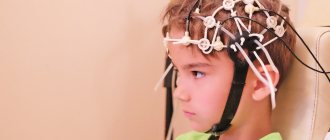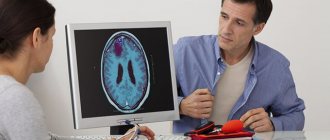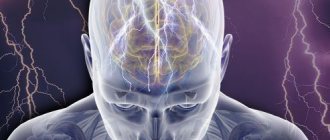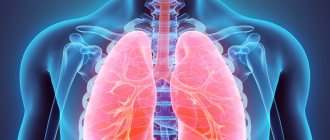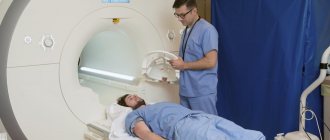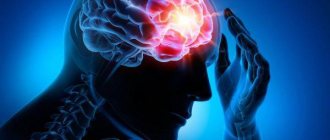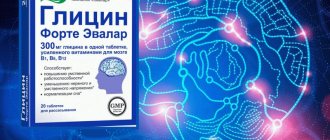Treatment and future prognosis for cryptogenic epilepsy
Epilepsy belongs to the category of chronic diseases. This pathology of the nervous system can be either congenital or acquired.
But regardless of the nature and characteristics of the diagnosis, the disease requires continuous treatment to stabilize the condition.
What is alcoholic epilepsy? Find out about this from our article.
What it is?
The term “cryptogenic” is used when it is not possible to determine the exact cause of the pathology.
Cryptogenic epilepsy is a disease of a psycho-neurological nature, manifested in the form of convulsive seizures.
However, the exact cause of the pathological condition and malfunction of the brain is unknown.
In the ICD-10 system, the disease is listed under code G40.
Focal epilepsy is a type of pathology caused by disorders localized in a clearly defined area of the brain.
Cryptogenic focal epilepsy is secondary (possibly somatic) in nature, not implying the presence of detectable morphological changes.
Causes of occurrence in children and adults
Cryptogenic epilepsy is diagnosed in more than 50% of cases . It can act as a temporary (interim) diagnosis when the exact causes of the disease cannot be established.
Etiology of focal epilepsy:
- craniocerebral injuries;
- complications after viral and bacterial diseases;
- circulatory disorders in the cervical spine (dysplasia, osteochondrosis, etc.);
- birth injuries;
- inflammatory processes in the brain;
- various lesions of the nervous system;
- arterial type hypertension.
In children, focal epilepsy develops mainly against the background of perinatal damage to the central nervous system, as well as a history of intrauterine infections.
It is also possible that a temporary focal lesion will develop, tied to an age threshold. Over time, the disease goes away without outside intervention.
But since positive dynamics appear only at the stage of the child becoming a teenager, it is necessary to take all necessary measures during the acute period of the disease (in the form of therapy that maintains a stable state and the exclusion of factors that provoke seizures).
In cryptogenic epilepsy (CE), the causes can be linked to any somatic disorder.
Factors that can provoke/influence the development of FE:
- strokes;
- genetic predisposition;
- intoxication of the body;
- hypothermia;
- overheating;
- acute stress;
- endocrine pathologies;
- meningitis and encephalitis.
There is no evidence that these factors are the cause of the development of cryptogenic epilepsy. Therefore, they are considered only as possible catalysts .
Symptoms and signs
Main symptoms of CE:
- sudden and often unpredictable attacks;
- concomitant mental disorders;
- loss of personality (process of active degradation)
- decrease in intellectual indicators.
Features of a cryptogenic seizure:
- increased motor and motor activity;
- vegetative “jumps” in the form of increased body temperature, dizziness and alternating increases and decreases in blood pressure;
- complete or partial clouding of consciousness, delirium.
- sleep disorders.
The standard scenario of a cryptogenic attack develops as follows: clonic convulsions and flexion of the limbs are accompanied by tachycardia and increased pressure, after which the patient’s skin turns pale and breathing is difficult.
It is also possible for the tongue to sink. After an attack, a person feels exhausted.
Structural focal epilepsy : signs and lesions:
- temporal (sensory attacks with concomitant loss of consciousness and the presence of oral and gestural automatisms);
- frontal (short serial paroxysms accompanied by complex automatic gestures);
- occipital (visual spectrum disorders, such as temporary blindness, hallucinations and narrowing of the visual field);
- parietal (somatosensory paroxysms with a high probability of concomitant short-term aphasia).
Cryptogenic focal epilepsy in children: features
Most often, children are diagnosed with Lennox-Gastaut syndrome and West syndrome , expressed in the form of focal seizures and atypical absences.
In this case, there are no warning signs of an attack.
The child, being in an absolutely stable state, falls sharply, the body is broken by convulsions or gestural automatisms appear. The patient may be fully or partially conscious, or may lose consciousness.
Consequences, complications
In patients with CE, mental abnormalities appear , such as:
- Violation of thought processes. A person cannot solve simple logic problems and loses the ability to build complex cause-and-effect relationships.
- Speech fixation on insignificant moments develops.
- Attacks of aggression and rage appear that cannot be controlled by the will.
- Some patients have a morbid tendency towards order.
Complications of epilepsy can be associated either directly with the pathology, or rather with its aggravation (for example, depression of consciousness), or with concomitant injuries.
After all, during an attack a person can fall, get injured and cut. An attack without an aura (precursors) can lead to falling down the stairs, loss of control over driving, etc.
It is also worth noting that a patient with epilepsy (especially in children) has problems with socialization and learning.
The quality of life is significantly reduced, a person does not feel like a full-fledged member of society and has difficulty establishing contacts.
In the absence of medical correction, a patient with epilepsy is forced to limit himself in all areas of life , even to the point of refusing to visit crowded places.
Forecast for the future
Is the disease curable or not? Epilepsy does not imply any preventive measures , since the pathogenesis of the disease is unclear and “vague”. But doctors advise avoiding injuries and situations in which the patient suffers serious infectious diseases “on his feet.”
There is no universal prognosis for patients with epilepsy, as well as a universal treatment regimen. Each individual patient requires an individual approach, a thorough study of the medical history, test results/examinations and current symptoms.
So, with idiopathic focal epilepsy in children, the probability of a favorable treatment outcome is extremely high (paroxysms often stop spontaneously, as the baby grows up and reaches juvenile status).
And in the case of symptomatic focal epilepsy, with the help of surgical treatment, doctors manage to correct the condition of patients with an occipital lesion in 70 cases out of a hundred.
Malignant forms of the disease are practically impossible to correct due to pharmacoresistance (immunity to drug treatment).
In this case, the person is assigned a third disability group. And in case of concomitant mental disorders, they are assigned to the second group.
If the patient does not want to see a doctor, death is possible . Thus, among patients diagnosed with “localized focal partial symptomatic epilepsy,” the mortality rate reaches 1.57%.
What is the disease in adults?
Epilepsy is one of the most common and severe neurological diseases that can occur at any age.
It provokes seizures - pathological uncontrolled bursts of activity in the neurons of the cerebral cortex, due to which the normal functioning of the latter is temporarily disrupted.
The seizure is usually accompanied by a short change of consciousness, and additionally by motor, behavioral and sensory disorders.
The ICD-10 code is G40 Epilepsy.
The causes of the disease are not yet clear enough, but it is assumed that they are related to the structure of the membranes of brain cells and their chemical characteristics.
Hereditary factors may also play a role.
Epilepsy is considered one of the most common neurological diseases, and according to WHO, it affects about 50 million people.
Cryptogenic epilepsy: what is it and how to treat this disease?
Epilepsy is defined by medicine as a chronic pathology of the central nervous system that has various causes. The main symptom of the disease is epileptic seizures that recur regularly. Diagnosis of cryptogenic epilepsy is made when brain damage is detected, accompanied by the impossibility of identifying the causes of the disease.
Cryptogenic epilepsy: what is it?
Cryptogenic epilepsy is a complex of epileptic symptoms, the causes of which have not been identified. This type of disease is hidden. Manifestations of cryptogenic pathology cannot be differentiated from symptoms of other types of epilepsy.
The disease manifests itself as a sudden onset of attacks in the form of motor disruptions, accompanied by a short-term disorder of thought processes, tactility and impairment of autonomic functions. The pathology is characterized by loss of consciousness and the formation of personality changes.
In cryptogenic epilepsy, spontaneous impulses are formed in the cerebral cortex, causing excessive stimulation of nerve transmission. As a result, a convulsive focus is formed, provoking an epileptic seizure.
Attacks can spread throughout the body or be focal. Cryptogenic focal epilepsy represents localized areas of pathological activity in the brain.
Symptomatic seizures develop in childhood, when there is a high probability of transition from the cryptogenic form to the symptomatic form, provided that the causes of the pathology are identified. Focal seizures most often develop in adults.
The symptomatic nature of the disease is revealed through a comprehensive examination. Local epileptic disorders are determined using the results of magnetic resonance imaging. Depending on the focus of epilepsy, cryptogenic pathology can be frontal, temporal, occipital, parietal.
If the focus of epileptic activity is localized in the temporal zone of the brain, if the patient exhibits regularly recurring emotions, the phenomenon of déjà vu, as well as the formation of seizures, a specialist can diagnose temporal lobe epilepsy.
This form of pathology is most often found in practical medicine.
Seizures accompanied by impaired visual sensitivity, uncontrolled eye movements, and intense headaches characterize epilepsy localized in the occipital area. This pathology is rare and is called “occipital epilepsy.”
Parietal pathology is accompanied by epiactivity of the crown area, which is responsible for the sensitivity of the body. Patients experience strange sensory sensations - tingling on one side of the body, distortion of the perception of their own limbs. This type of disease is a rare form of epilepsy accompanied by partial seizures.
Varieties
Cryptogenic disease is divided into subtypes with varying prevalence. Patients may experience multiple types of seizures. Some doctors consider cryptogenic epilepsy as an intermediate diagnosis that requires the use of additional diagnostic methods.
West syndrome
This variant of cryptogenic epilepsy manifests itself at an early age - from 2 to 4 months. The main symptom of this type of neuropsychiatric pathology is seizures that spontaneously arise and cease. The disease provokes a delay in the intellectual development of the child.
Once the patient reaches 12 months, the pathology may cease on its own or be modified into another type, for example, develop into Lennox syndrome, accompanied by various types of attacks.
Lenox-Gastaut syndrome
This type of disease refers to the childhood form of epilepsy, developing in a child 2-8 years old. The syndrome can form independently or transform from a condition that develops at an earlier age.
The pathology is manifested by a sudden loss of balance, short-term hearing loss. In most cases there is no loss of consciousness.
Regular attacks cause mental retardation and increase the likelihood of injury.
Myoclonic-astatic form
Epilepsy of this form is diagnosed from 5 months to 5 years. The main symptom that develops at a young age is a grand mal seizure - generalized convulsions. Attacks of loss of balance are observed in children who can walk.
The attack consists of sharp and rapid movements of the limbs, nodding of the head, and the sensation of a blow to the knee area. Most often, a seizure occurs after getting up in the morning.
Myoclonic absence seizures
This type of epilepsy is detected in the age group from 1 to 12 years. Myoclonic seizures are the first type of seizure in most cases. Before such seizures are detected, half of the children show a delay in the rate of mental development.
The pathology is accompanied by partial or complete loss of consciousness, involvement of the muscles of the shoulder girdle, limbs, and face in sudden absence seizures.
The duration of such an episode is 10-60 seconds. Attacks may occur several times a day.
Partial seizures
There are several types of partial seizures, among which the following seizures stand out:
- Motor, accompanied by muscle contraction in certain areas of the body. The attack passes and occurs suddenly, no loss of consciousness is observed.
- Sensory, characterized by the sudden onset of such sensations - heat, cold, goosebumps, burning, tingling. There are disturbances in the functioning of the senses in the form of hallucinations.
- Mental, characterized by spontaneous disturbances in speech and mental activity, loss of balance, and hallucinations.
- Vegetative, the features of which are increased sweating, changes in body temperature in certain areas of the skin, and heart rhythm disturbances.
Visceral and autonomic seizures
They occur in the form of painful sensations in the throat and head. In some cases, an erection or orgasm may be observed. Autonomic disorders are accompanied by failure of thermoregulation and pressure surges. Often both types of attacks are mixed. Vegetative-visceral seizures have a number of features:
- the duration of the attack is 5-10 minutes;
- presence of seizures;
- absence of provoking factors;
- possible combination with other forms of seizures;
- a feeling of disorientation that occurs after the seizure ends.
Situational seizures
Several factors can provoke an epileptic attack: drugs and alcohol, medications, brain injuries, intoxication, viral blood infections, heart and liver dysfunction.
Such attacks can be caused by exposure to excessively bright light, extremely high or low temperatures, or loud sounds. The listed factors can activate the underlying mechanism for the development of epileptic seizures.
Causes
The exact reasons for the formation of epileptic activity of a cryptogenic nature have not been identified by medical specialists. Possible causes leading to the appearance of epilepsy of any form include the following situations:
- hereditary factor;
- complications of traumatic brain injury;
- consequence of a stroke;
- intoxication with chemicals.
The leading factor provoking the development of epilepsy is family history. Despite the variety of suspected causes, it was not possible to scientifically establish the source of the pathological condition.
Forecast
The prognosis of the pathology is ambiguous, since timely detection and proper treatment of the disease improve the patient’s well-being. Among the most likely complications of epilepsy are the following conditions:
- coma;
- injuries of varying complexity;
- respiratory depression;
- heartbeat disturbance;
- Alzheimer's disease;
- emotional changes.
If seizures occur in childhood, the process of socialization changes, personal qualities develop abnormally, and intellectual development suffers.
Source: https://mozgmozg.com/bolezni/kriptogennaya-epilepsiya
Classification
According to the International Classification of 1989 (International League Against Epilepsy), generalized epilepsy is based on the generalization of epileptic activity. Within GE, forms are distinguished: idiopathic, symptomatic and cryptogenic. Generalized types of epilepsy and syndromes: 1. Idiopathic (with age-dependent onset). ICD-10: G40.3: – benign familial neonatal seizures; – benign idiopathic neonatal seizures; – benign myoclonic epilepsy of early childhood; – childhood absence epilepsy (ICD-10: G40.3); – juvenile absence epilepsy; – juvenile myoclonic epilepsy; – epilepsy with seizures of awakening; – other types of idiopathic generalized epilepsy (ICD-10: G40.4); – epilepsy with seizures provoked by specific factors. 2. Cryptogenic and (or) symptomatic (with age-dependent onset) – ICD-10: G40.5: – West syndrome (infantile spasms); – Lennox-Gastaut syndrome; – epilepsy with myoclonic-astatic seizures; – epilepsy with myoclonic absence seizures. 3. Symptomatic. 3.1 Nonspecific etiology: – early myoclonic encephalopathy; – early infantile epileptic encephalopathy with “flare-suppression” complexes on the EEG; – other types of symptomatic generalized epilepsy. 3.2 Specific syndromes.
Information
Sources and literature
- Protocols for the diagnosis and treatment of diseases of the Ministry of Health of the Republic of Kazakhstan (Order No. 764 of December 28, 2007) 1. Hopkins A., Appleton R. Epilepsy: Oxford University Press.1996. 2. International Classification of Diseases 10th revision; 3. International League Against Epilepsy (ILAE).Epilepsia 1989 vol. 30-P.389-399. 4. K.Yu.Mukhin, A.S.Petrukhin “Idiopathic epilepsies: diagnosis, tactics, treatment”. M., 2000. 5. Diagnosis and treatment of epilepsy in children. Edited by P.A. Temin, M.Yu .Nikanorova, 1997 6. Modern ideas about childhood epileptic encephalopathy with diffuse slow peak waves (Lennox-Gastaut syndrome).K.Yu. Mukhin, A.S. Petrukhin, N.B. Kalashnikov. Educational method. Benefit. RGMU, Moscow, 2002. 7. Progress in Epileptic Disorders “Cognitive Dysfunction in Children with Temporal Lobe Epilepsy.” France, 2005. 8. Aicardi J. Epilepsy in children.-Lippincott-Raven, 1996.-P.44-66. 9. Marson AG, Williamson PR, Hutton JL, Clough HE, Chadwick DW, on behalf of the epilepsy monotherapy trialists. Carbamazepine versus valproate monotherapy for epilepsy. In: The Cochrane Library, Issue 3, 2000; 10. Tudur Smith C, Marson AG, Williamson PR. Phenotoin versus valproate monotherapy for partial onset seizures and generalized onset tonic-clonic seizures. In: The Cochrane Library, Issue 4, 2001; 11. Evidence-based medicine. Annual directory. Part 2. Moscow, Media Sphere, 2003. pp. 833-836. 12. First Seizure Trial Group (FIRST Group). Randomized clinical trial on the efficacy of antiepileptic drugs in reducing the risk of relapse after a first unprovoked tonic clonic seizure. Neurology 1993;43:478-483; 13. Medical Research Council Antiepileptic Drug Withdrawal Study Group. Randomized study of antiepileptic drug withdrawal in patients in remission. Lancet 1991; 337: 1175-1180. 14. Clinical guidelines for practicing physicians, based on evidence-based medicine, 2nd edition. GEOTAR-MED, 2002, pp. 933-935. 15. Never rugs for epilepsy in children. National Institute for Clinical Excellence. Technology Appraisal 79. April 2004. https://www.clinicalevidence.com. 16. Brodie MJ. Lamotrigine monotherapy: an overview. In: Loiseau P (ed). Lamictal – a brighter future. Royal Society of Medicine Herss Ltd, London, 1996, pp 43-50. 17. O'Brien G et al. Lamotrigine in add-on therapy in treatment-resistant epilepsy in mentally handicapped patients: an interim analysis. Epilepsia 1996, in press. 18. Karseski S., Morrell M., Carpenter D. The Expert Consensus Guideline Series: Treatment of Epilepsy. Epilepsy Epilepsy Behav. 2001; 2:A1-A50. 19. Hosking G et al. Lamotrigine in children with severe developmental abnormalities in a pediatric population with refractory seizures. Epilepsy 1993; 34 (Suppl): 42 20. Mattson RH. Efficacy and adverse effects of established and new antiepileptic drugs. Epilepsy 1995; 36 (suppl 2): 513-526. 21. Kalinin V.V., Zheleznova E.V., Rogacheva T.A., Sokolova L.V., Polyansky D.A., Zemlyanaya A.A., Nazmetdinova D.M. Use of the drug Magne B6 for the treatment of anxiety and depressive conditions in patients with epilepsy. Journal of Neurology and Psychiatry 2004; 8: 51-55 22. Barry J., Lembke A., Huynh N. Affective disorders in epilepsy. In: Psychiatric issues in epilepsy. A practical guide to diagnosis and treatment. A. Ettinger, A. Kanner (Eds.). Philadelphia 2001; 45-71. 23. Blumer D., Montouris G., Hermann B. Psychiatric morbidity in seizure patients on a neurodiagnostic monitoring unit. J Neuropsychiat Clin Neurosci 1995; 7:445-446. 24. Edeh J., Toone B., Corney R. Epilepsy, psychiatric morbidity, and social dysfunction in general practice. Comparison between hospital clinic patients and clinic non-attenders. Neuropsychiat Neuropsychol Behav Neurol 1990; 3: 180-192. 25. Robertson M., Trimble M., Depressive illness in patients with epilepsy: a review. Epilepsy 1983; 24: Supple 2:109-116. 26. Schmitz B., Depressive disorders in epilepsy. In: Seizure, affective disorders and anticonvulsant drugs. M. Trimble, B. Schmitz (Eds.). UK 2002; 19-34.
Information
List of developers:
Doctor of Medical Sciences, Prof. Lepesova M.M., Head of the Department of Child Neurology, AGIUV
Symptoms
The clinical picture of the disease is very diverse. It is not limited to typical generalized convulsions with loss of consciousness.
Often, parents do not notice the symptoms of the pathology or attribute them to age-related characteristics, especially in babies under one year old.
Main features:
- Absence seizures. Usually they occur unnoticed by others. The child freezes for a few seconds, looks at one point, and does not react to external stimuli. Then he returns to his studies.
- Myoclonic spasms. Characterized by uncontrolled movements of body parts without loss of consciousness.
- Tonic seizures. The patient suddenly experiences contraction of all muscles, causing a fall.
- Atonic convulsions. The patient's muscles suddenly relax and he falls to the ground.
- Generalized seizures . These are the classic attacks with which the disease is associated. The seizure begins with tonic muscle tension, the patient falls and loses consciousness. Next comes the clonic phase: contraction of muscle groups, foam at the mouth, hoarse breathing. After 2-5 minutes, the muscles relax, the patient does not remember what happened, and falls asleep for a long time.
Parents should be alert to the following symptoms:
- Sharp screams.
- Throwing back the head, rolling the eyes.
- Trembling of the chin, hands, head.
- Increased night sweats.
Hereditary predisposition to the disease
It is believed that having a close relative with epilepsy significantly increases the risk of such a disease. According to the results of studies, a child whose parent has experienced this disease increases the risk of developing a neurological disease by 6%.
Despite the fact that hereditary predisposition is considered a provoking factor, it cannot be said that the disease is inherited. This is due to the fact that the pathology is caused by numerous reasons and has different development mechanisms. In the overwhelming majority of cases, disturbances in brain function arise due to disorders acquired in the course of life.
Risk factors
The mechanism of development of the described pathology is not reliably known. Seizures are often diagnosed in healthy people who have not previously shown signs of illness.
Risk factors include:
- Injuries suffered
- Excessive stress loads
- Psycho-emotional shocks
- Infectious diseases
- Bad habits
- Parasitic infestations
- Computer addiction
- Chronic lack of sleep
A concomitant factor in this case is the use of medications.
Anticonvulsants
This is a group of medications whose action reduces the intensity and frequency of seizures. The mechanism of action is based on blocking sodium and calcium channels in nerve cells, preventing the formation of an extensive epileptic focus.
Common medications include:
- Diazepam
- Clonazepam
- Phenobarbital
- Carbamazepine
- Lamotrigine
- Trimethine
The medicine is selected individually, taking into account clinical manifestations. With the right therapy, you can reduce the frequency of seizures and completely eliminate them. Medicines are intended for systematic use. Cancellation is possible if there are no attacks for more than 2-3 years.
Features in childhood
The most common manifestation of convulsive syndrome in children is febrile seizures. Newborns and children under 6 years of age are most at risk of developing an attack. If seizures recur in older children, then it is necessary to suspect epilepsy and consult a specialist. Febrile seizures can occur with any infectious or inflammatory disease that is accompanied by a sharp increase in body temperature.
In the International Classification of Diseases, Tenth Revision, this pathology is coded R56.0
.
If your baby has convulsive muscle twitching due to fever, then you need to:
- call an ambulance;
- lay the child on a flat surface and turn his head to the side;
- after the seizure stops, give an antipyretic;
- provide a flow of fresh air into the room.
You should not try to open your child's mouth during an attack, as you may injure both yourself and him.
Diagnostics
Making a diagnosis begins with taking a family history. The doctor listens to parents' complaints about emerging symptoms.
The main diagnostic method is an encephalogram. Sensors are attached to the patient's head to measure neuronal activity.
To differentiate epilepsy from other diseases, MRI of the brain is prescribed . The study allows us to detect tumors, consequences of injuries and neuroinfections that led to the disease.
If endocrine disorders are suspected, a biochemical blood test and hormone tests are performed.
Prevention methods
There are no specific methods of prevention. To reduce the risk of developing the disease, factors that provoke it should be eliminated. It is recommended to prevent head injuries, promptly treat infectious diseases, and give up bad habits. It is also advised to monitor the condition of blood vessels and combat high blood pressure.
Epilepsy is considered a difficult to treat neurological disease. The disease manifests itself in the form of periodic attacks that go away on their own or are controlled with medication. Modern methods of pharmacological therapy can reduce the frequency of seizures. If left untreated, the disease can cause irreversible consequences in the brain, leading to disability or death.
Symptomatic epilepsy (ICD 10 code – G40.2): causes of development
Most often, the occurrence of symptomatic epileptic seizures is caused by the following provoking factors:
- volumetric formations of the central nervous system;
- hereditary metabolic diseases;
- alcohol withdrawal;
- infectious diseases of the nervous system (for example, meningoencephalitis);
- traumatic brain injuries (spontaneous or traumatic intracranial hematoma, brain contusions);
- prolonged insomnia and psychological stress;
- eclampsia;
- cerebral infarction, venous sinus thrombosis;
- hyperventilation, flickering light (if photosensitivity is present).
Causes
Regardless of age, the causes of the development of symptomatic epilepsy can be:
- rheumatological diseases;
- infectious diseases that affect the brain and provoke the development of meningitis, encephalitis, herpes;
- head injuries of varying severity (including birth injuries);
- strokes;
- development of neoplasms and tumors in the neck and brain;
- malformation in the vascular system of the brain (pathological fusion of capillaries and veins);
- drug or alcohol intoxication.
The younger the patient, the higher the risk of developing epilepsy when exposed to external or internal factors.
General information
Epilepsy is considered an independent disease, but is additionally considered only as a syndrome occurring against the background of a certain pathological process. There are no differences in the clinical picture.
The disease often manifests itself in childhood. Therefore, it is believed that one of the provoking factors is genetic predisposition.
The occurrence of seizures is associated with a disruption in the electrical conductivity of nerve cells in the brain. A charge accumulates in a region of the brain, which is subsequently released and spreads to neighboring cells or the entire brain. As a result, the patient experiences motor disturbances for a short period of time, after which he loses consciousness.


